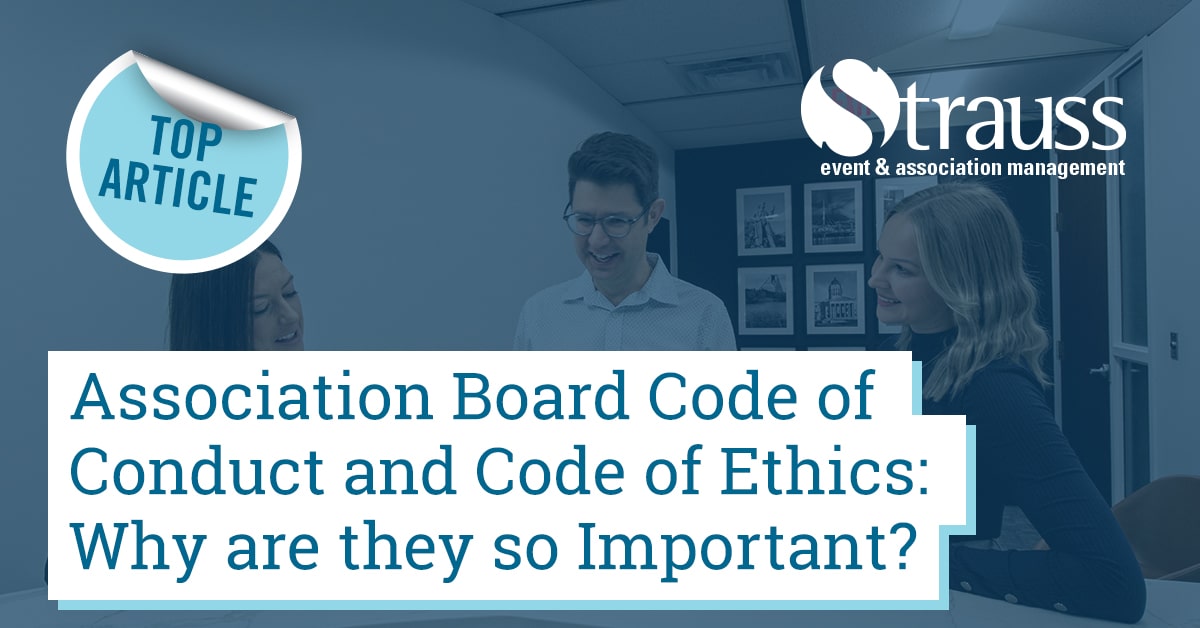A board of directors’ Code of Conduct and Code of Ethics are valuable tools in board related issues. Recent events spurred me to write this article to emphasize the importance of incorporating these two documents into an association’s board member orientations, ensuring that they are signed annually and ensuring that they are updated as needed.
Many board members think that the by-laws address all possible issues that a board can face. However, they often do not, and can confuse board members on what is “right or wrong” and if personal behavior affects the reputation of the organization. Policies set rules on how to conduct business while bylaws relate to the functioning of the board and its relationship to members. For more information on bylaws, please reference my colleague’s articles:
- https://strauss.ca/how-important-are-association-by-laws/
- https://strauss.ca/association-by-laws-what-are-they-good-for/
What is a Code of Conduct?
A Code of Conduct outlines fundamental principles and practices for avoiding conflicts of interest it acts as a set of rules for ethical responsibilities and behaviors. It encourages ethical conduct, ensures the highest standards and maintains the reputation and integrity of an association. It dives deeper into conflicts of interest by disclosing involvement with other organizations, businesses or individuals where those relationships can be viewed as a conflict.
Non-profit board members must conduct themselves in a particular manner. They must meet standards of conduct while carrying out the responsibilities to the association they represent. These standards are typically called duty of care, duty of loyalty and duty of obedience. Here are short summaries of each standard:
- 1) Duty of Care: Exercising care when making a decision as a representative of the association.
- 2) Duty of Loyalty: Acting in the best interest of the organization and not using information obtained for personal gain.
- 3) Duty of Obedience: Being faithful to the organization’s mission. Acting in a way that is consistent with the goals of the association and obeying the law and organizational rules and regulations.
Please read more on conflict of interests here.
What is a Code of Ethics?
A Code of Ethics conveys a strong message that targets an organization’s culture and work both internally and externally. It serves as a predominant statement for other policies that establish standards of integrity and accountability. It outlines the process for implementing the defined culture and values within an organization.
Why do These Documents Matter?
A Code of Ethics and Code of Conduct promotes ethical behaviour. Associations must have board members who, while at the forefront of an organization, uphold the most legal, ethical and moral standards, at and beyond the board table. Reputation is very important in demonstrating integrity and excellence; it requires careful observance of application laws and regulations, as well as scrupulous regard for standards of conduct and personal integrity. Association members must see the board of directors as leaders in the industry or profession and surrounding community. It should also be evident that these board members are volunteering for the association for the goodness of the association and to ensure the association is performing at its highest capacity.
The association must comply with all laws and regulations, expect the directors and officers to also conduct business in accordance of all relevant laws and to refrain from illegal, dishonest or unethical behavior both professionally and individually. If this occurs, these policies can direct the board of directors in the right direction to address the situation. Unlike bylaws, these policies can provide a course for a direct and concise solution.
If a situation arises where it is difficult to determine the proper course of action, or when an individual’s conduct is in question, the matter should be brought to the board’s attention. The board will make relevant determinations where the individual in question will not participate. The board will consult these policies to determine if a there was a breach, and how to proceed.
How to Create a Board Code of Ethics and Code of Conduct
Every organization will have their own unique Code of Conduct and Code of Ethics documents. However, each one should include some general information. By signing the code of conduct, you promise to demonstrate the highest standard of personal integrity, truthfulness, honesty and fortitude in all activities to inspire trust and confidence in the association’s activities. It should also include that Directors and Officers should not use their positions to obtain unreasonable or excessive services or expertise of staff.
Board members must avoid any interest or activity that conflicts with the conduct of the official duties of the association. Board members also cannot gain personal benefit from relationships established by any officer or board member using the organization’s name. Additionally, they cannot use financial resources or services for their own personal benefit. If needed, consulting the association’s legal council is an option to ensure that the association is addressing behavior appropriately. Your lawyer will help you to define the behaviors and identify if there is indeed a breach.
Take-Away
When introducing these policies to your board volunteers, emphasize that these policies protect the association and its members. They are on the board for the best interest of the association and its mandate.
These policies protect the organization’s purpose, it’s members and the board of directors. Ultimately, they help eliminate uncomfortable situations and allow for clear and concise decisions to be made regarding board member behavior.

